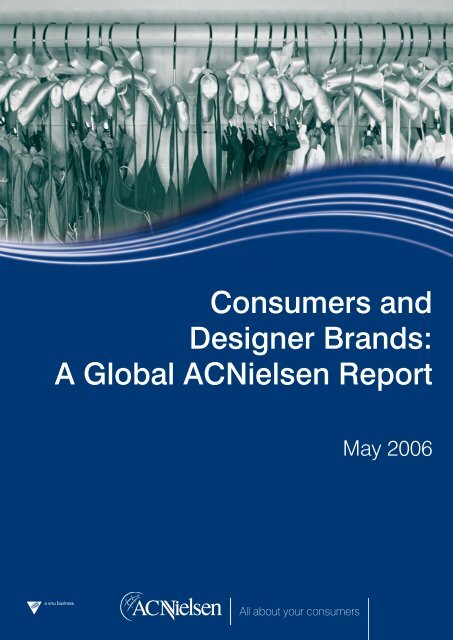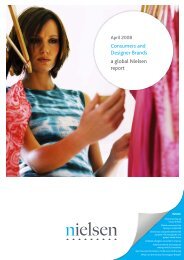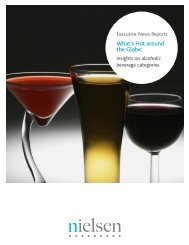Consumers and Designer Brands: A Global Acnielsen Report
Consumers and Designer Brands: A Global Acnielsen Report
Consumers and Designer Brands: A Global Acnielsen Report
You also want an ePaper? Increase the reach of your titles
YUMPU automatically turns print PDFs into web optimized ePapers that Google loves.
<strong>Consumers</strong> <strong>and</strong><br />
<strong>Designer</strong> Br<strong>and</strong>s:<br />
A <strong>Global</strong> ACNielsen <strong>Report</strong><br />
May 2006
According to a recent ACNielsen survey,<br />
Ralph Lauren is currently the most popular<br />
designer br<strong>and</strong> globally, but Gucci <strong>and</strong><br />
Giorgio Armani are the most aspired to,<br />
if money were no object.<br />
According to an ACNielsen global<br />
online survey of 21,000 consumers in<br />
42 countries, Ralph Lauren is the world’s<br />
most popular designer br<strong>and</strong>, followed<br />
by Gucci, Christian Dior <strong>and</strong> DKNY. Yet<br />
when it comes to the most coveted br<strong>and</strong><br />
if money were no object, Italian fashion<br />
powerhouses take the lead, with Giorgio<br />
Armani the most aspired-to, followed by<br />
Gucci.<br />
100%<br />
90%<br />
80%<br />
70%<br />
60%<br />
50%<br />
40%<br />
30%<br />
20%<br />
10%<br />
0%<br />
Base: all respondents<br />
40%<br />
36%<br />
50% 49%<br />
28% 30%<br />
21% 20% 20%<br />
ACNielsen’s global online survey was<br />
conducted on the Internet in November<br />
2005, asking 21,000 consumers in 42<br />
markets across Europe, Asia Pacific,<br />
UAE, North <strong>and</strong> Latin America about their<br />
current <strong>and</strong> aspirational fashion br<strong>and</strong><br />
purchasing.<br />
To what extent do you agree with the following statements:<br />
I buy designer br<strong>and</strong>s<br />
1% 1% 1% 1% 0% 1%<br />
24%<br />
Agree Neutral Disagree Don’t know<br />
Latin America Europe Asia-Pacific Other North America <strong>Global</strong> average<br />
44%<br />
35%<br />
60%<br />
26%<br />
14%<br />
49%<br />
30%<br />
21%<br />
To what extent do you agree with the following statements:<br />
Many people I know buy designer br<strong>and</strong>s<br />
100%<br />
90%<br />
80%<br />
70%<br />
60%<br />
50%<br />
40%<br />
30%<br />
20%<br />
10%<br />
0%<br />
Base: all respondents<br />
3%<br />
10%<br />
4% 8% 6% 5% 6%<br />
19%<br />
21%<br />
24% 28% 27% 24%<br />
67%<br />
Agree Neutral Disagree Don’t know<br />
29%<br />
45%<br />
27% 24% 28%<br />
42% 41% 39%<br />
Latin America Other Europe North America Asia-Pacific <strong>Global</strong> average<br />
26%<br />
44%
Attitudes towards luxury br<strong>and</strong>s differ<br />
worldwide As many as one fifth of Internet<br />
users worldwide confess to buying the<br />
world’s most famous designer br<strong>and</strong>s,<br />
although nearly half claim to know someone<br />
else rich enough – or image-conscious<br />
enough - to buy them too.<br />
“<strong>Consumers</strong> unanimously agree that<br />
designer br<strong>and</strong>s are overpriced. However,<br />
people are willing to pay extra for the<br />
certain social status these br<strong>and</strong>s project.<br />
<strong>Designer</strong> products are not only for the<br />
‘slaves of fashion’. Sixty percent of our<br />
survey participants associate designer<br />
br<strong>and</strong>s with social status, while only 34<br />
percent say they are only for the fashionconscious,”<br />
says Tom Markert, Senior<br />
Vice-President, <strong>Global</strong> Marketing for<br />
ACNielsen.<br />
In Europe, the cradle of fashion, wearing<br />
designer br<strong>and</strong>s is considered the norm<br />
<strong>and</strong> not only for the fashion conscious.<br />
Less than a third of Europeans, especially<br />
in such countries as the Nordics,<br />
Germany, Austria, Eastern Europe <strong>and</strong> the<br />
Mediterranean countries of Greece, Italy<br />
<strong>and</strong> Turkey, claim designer br<strong>and</strong>s to be for<br />
fashion followers only. At the other end of<br />
the scale, however, the French, British <strong>and</strong><br />
Dutch internet users are among those least<br />
likely to indulge themselves with designer<br />
labels.<br />
British <strong>and</strong> Spanish consumers top<br />
European rankings in believing that<br />
designer br<strong>and</strong>s are overpriced. This is<br />
largely due to the existence <strong>and</strong> success<br />
of high-street br<strong>and</strong>s originating from these<br />
countries <strong>and</strong> local consumers getting<br />
designer-style clothes <strong>and</strong> accessories<br />
at a fraction of famous design br<strong>and</strong><br />
prices. Indeed, the high-street fashion<br />
successes from Spain <strong>and</strong> Britain – Zara,<br />
Mango, Topshop <strong>and</strong> Marks & Spencers<br />
– are exp<strong>and</strong>ing rapidly throughout other<br />
regions of the world, offering men <strong>and</strong><br />
women everywhere the option of looking<br />
fashionable in current design trends without<br />
burning a hole in their wallets.<br />
In the developing markets of Latin America,<br />
Asia, South Africa <strong>and</strong> the UAE, however,<br />
designer br<strong>and</strong>s st<strong>and</strong> for fashion <strong>and</strong><br />
superior quality. A half of respondents in<br />
these countries think these br<strong>and</strong>s are for<br />
fashion followers, <strong>and</strong> up to 40 percent<br />
believe they offer superior quality.<br />
On the matter of quality, North Americans<br />
are the world’s most sceptical when it<br />
comes to designer br<strong>and</strong>s, with only<br />
18 percent believing they surpass their<br />
non-designer counterparts on quality.<br />
As many as 36 percent of Internet users<br />
in North America – twice more than in<br />
any other region - believe that imitation<br />
designer br<strong>and</strong>s are just as good as the<br />
real ones.<br />
Interestingly, the greatest percentage of<br />
people who believe designer br<strong>and</strong>s offer<br />
significantly higher quality over their nondesigner<br />
alternatives hail from Malaysia,<br />
Taiwan, Hong Kong <strong>and</strong> Turkey – all<br />
countries where many of these fashion<br />
houses are likely to outsource their<br />
production to <strong>and</strong> where imitation br<strong>and</strong>s<br />
are widely found!<br />
Acceptance of imitation design br<strong>and</strong>s in<br />
Europe is highest in Norway, Switzerl<strong>and</strong><br />
<strong>and</strong> Austria <strong>and</strong> least acceptable among<br />
Greeks, Czechs <strong>and</strong> Italians who prefer the<br />
buy ‘the real thing’ or nothing at all.<br />
To what extent do you agree with the following statements:<br />
<strong>Designer</strong> br<strong>and</strong>s are usually overpriced for what they are<br />
100%<br />
90%<br />
80%<br />
70%<br />
60%<br />
50%<br />
40%<br />
30%<br />
20%<br />
10%<br />
0%<br />
Base: all respondents<br />
3%<br />
1% 1%<br />
4% 2% 1% 3% 2%<br />
4% 6%<br />
10%<br />
7%<br />
6%<br />
13%<br />
15% 14%<br />
15%<br />
15%<br />
87%<br />
Agree Neutral Disagree Don’t know<br />
82% 79% 79%<br />
North America Latin America Other Asia-Pacific Europe <strong>Global</strong> average<br />
To what extent do you agree with the following statements:<br />
Imitation designer br<strong>and</strong>s are just as good as the real ones<br />
100%<br />
90%<br />
80%<br />
70%<br />
60%<br />
50%<br />
40%<br />
30%<br />
20%<br />
10%<br />
0%<br />
Base: all respondents<br />
21%<br />
38%<br />
42%<br />
44%<br />
32% 35%<br />
75%<br />
31% 31%<br />
77%<br />
5% 8% 6% 5% 6% 7%<br />
36%<br />
Agree Neutral Disagree Don’t know<br />
49% 50% 44%<br />
32%<br />
19% 16% 15% 14% 17%<br />
North America Europe Other Latin America Asia-Pacific <strong>Global</strong> average
What’s in a designer name? According<br />
to the ACNielsen survey, US designer<br />
Ralph Lauren is the most frequently bought<br />
luxury br<strong>and</strong> worldwide from the list of 18<br />
br<strong>and</strong>s surveyed. Ralph Lauren products<br />
are bought by 15 percent of Internet users,<br />
followed by Dior (13%), Giorgio Armani,<br />
Gucci (12%) <strong>and</strong> YSL (11%).<br />
In Asia Pacific, Louis Vuitton (LV) also<br />
made the top five ranking, with at least one<br />
in ten claiming to have bought the French<br />
br<strong>and</strong>’s products. In fact, nine of the top<br />
10 markets with most people buying LV<br />
products hailed from Asia Pacific, with<br />
Hong Kong (23%) <strong>and</strong> Japan (17%) the<br />
top two markets globally purchasing Louis<br />
Vuitton.<br />
Besides LV, Asia comprised most of the top<br />
10 markets for current product ownership<br />
of br<strong>and</strong>s like Prada (6), Celine (7) <strong>and</strong><br />
Ferragamo (8).<br />
It’s worth noting that Philippines ranked<br />
number one in the world top ten list with<br />
most people claiming to buy Ralph<br />
Lauren (34%) <strong>and</strong> Celine (18%) products,<br />
while Koreans top the list for Ferragamo’s<br />
products (12%).<br />
Currently in Europe, it’s a close run thing<br />
between Ralph Lauren, Giorgio Armani <strong>and</strong><br />
Christian Dior for the top three most bought<br />
br<strong>and</strong>s today.<br />
The story is a bit different in the Pacific<br />
where local fashion designers in Australia<br />
<strong>and</strong> New Zeal<strong>and</strong> are prospering. High<br />
import taxes for design br<strong>and</strong> products<br />
combined with the differences of seasons<br />
in the southern hemisphere <strong>and</strong> relaxed,<br />
outdoor lifestyle of Aussies <strong>and</strong> Kiwis make<br />
their local designers more wearable <strong>and</strong><br />
affordable. It is hard to find consumers in<br />
Australia <strong>and</strong> New Zeal<strong>and</strong> who st<strong>and</strong> out<br />
for a particular international br<strong>and</strong>.<br />
And if money were no object? However,<br />
one in three consumers from the online<br />
world said they would purchase Giorgio<br />
Armani or Gucci if money were no object.<br />
“It is a remarkable testament to the power<br />
<strong>and</strong> universal appeal of these two luxury<br />
br<strong>and</strong>s. Giorgio Armani <strong>and</strong> Gucci fashion<br />
houses clearly underst<strong>and</strong> that strong<br />
br<strong>and</strong>s make for profitable businesses.<br />
They are not merely selling fashion, they are<br />
selling an image – something consumers<br />
are willing to pay a premium for”, said<br />
Markert.<br />
“Regardless of where they live, when<br />
consumers in Italy, China or UAE purchase<br />
a Gucci bag or a Giorgio Armani suit they<br />
are prepared to pay a premium because<br />
they are buying the image the br<strong>and</strong><br />
represents. In Armani’s case, consumers<br />
know they are getting quality, sophistication<br />
<strong>and</strong> style – timeless values with global<br />
appeal. For Gucci, it’s the combination<br />
of heritage, together with its sexy, modern<br />
appeal.”<br />
Next on the list of the most desired br<strong>and</strong>s<br />
in the wardrobes of the world’s fashion<br />
followers were Versace (27%), Christian<br />
Dior (25%) <strong>and</strong> Chanel (23%).<br />
To what extent do you agree with the following statements:<br />
<strong>Designer</strong> br<strong>and</strong>s are of significantly higher quality than st<strong>and</strong>ard br<strong>and</strong>s<br />
100%<br />
90%<br />
80%<br />
70%<br />
60%<br />
50%<br />
40%<br />
30%<br />
20%<br />
10%<br />
0%<br />
2% 2% 4% 5% 3% 4%<br />
27% 27% 26%<br />
32%<br />
39%<br />
Agree Neutral Disagree Donʼt know<br />
35% 35%<br />
35% 34%<br />
39% 45%<br />
Latin America Asia-Pacific Other Europe North America <strong>Global</strong> average<br />
Base: all respondents<br />
To what extent do you agree with the following statements:<br />
Only fashion conscious people consider buying designer br<strong>and</strong>s<br />
100%<br />
90%<br />
80%<br />
70%<br />
60%<br />
50%<br />
40%<br />
30%<br />
20%<br />
10%<br />
0%<br />
Base: all respondents<br />
34%<br />
22%<br />
27% 27% 30% 26%<br />
26% 28% 27% 31%<br />
42% 41% 40%<br />
34%<br />
18%<br />
2% 3% 2% 3% 4% 3%<br />
45%<br />
Agree Neutral Disagree Don’t know<br />
42%<br />
28%<br />
26%<br />
33%<br />
34%<br />
28%<br />
Latin America Other Asia-Pacific North America Europe <strong>Global</strong> average<br />
35%<br />
28%<br />
34%
<strong>Consumers</strong> in Asia Pacific certainly had<br />
their own list of preferences were money<br />
no object – leading consumers in all other<br />
regions in their aspirations towards Louis<br />
Vuitton (32%), with Hong Kong housing<br />
the world’s most admirers of the br<strong>and</strong><br />
– justifying the recent opening of LV’s<br />
flagship store in the city. Other br<strong>and</strong>s<br />
that top the list for Asia Pacific consumers<br />
include Hermes, DKNY, Ferragamo <strong>and</strong><br />
Bottega Venetta.<br />
Fashion consumers remain loyal to<br />
homegrown designers Not surprisingly,<br />
consumers in the world’s fashion capitals<br />
– USA, Italy <strong>and</strong> France – remain loyal<br />
first <strong>and</strong> foremost to their own country<br />
designers.<br />
North American consumers choose the top<br />
US designer Ralph Lauren, who topped<br />
the US online consumer’s choice for<br />
current <strong>and</strong> most coveted fashion br<strong>and</strong> of<br />
the future. However, European labels most<br />
coveted for future purchase were Gucci<br />
<strong>and</strong> Giorgio Armani.<br />
Historic French design houses, Yves Saint<br />
Laurent (despite now being owned by an<br />
Italian fashion conglomerate), Chanel, Dior<br />
<strong>and</strong> Hermes have the strongest following<br />
in France at present, as well as for future<br />
purchase. Meanwhile, fashion-conscious<br />
Italians clearly out-rank Giorgio Armani,<br />
Prada, Emporio Armani <strong>and</strong> Versace<br />
among their most coveted fashion br<strong>and</strong>s<br />
today – as well as in the future.<br />
Fast growing markets - tomorrow’s<br />
fashion Meccas The future survival of<br />
leading fashion houses depends on br<strong>and</strong><br />
longevity <strong>and</strong> it is no surprise that designer<br />
fashion houses have been investing in their<br />
future by building commercial <strong>and</strong> br<strong>and</strong><br />
presences in the fast growing markets of<br />
Asia, UAE <strong>and</strong> Russia.<br />
Making up the world’s most populated<br />
nation, Chinese consumers who can<br />
afford designer br<strong>and</strong>s are currently<br />
‘investing’ in Chanel (15%), LV (13%) <strong>and</strong><br />
Versace (12%) the most among other<br />
br<strong>and</strong>s. The potential for these br<strong>and</strong>s is<br />
far greater with as many as 38 percent of<br />
future big spenders saying they would opt<br />
for Versace <strong>and</strong> Chanel <strong>and</strong> a third for LV.<br />
The effort of all the fashion shows held in<br />
Shanghai these days is worth it!<br />
<strong>Global</strong> results from the ACNielsen survey<br />
reveal that Christian Dior – which has<br />
also successfully re-positioned itself with<br />
a more youthful image <strong>and</strong> is a favourite<br />
Base: all respondents<br />
among the international young ‘IT’ crowd<br />
- has high commercial potential in UAE,<br />
Russia, Latin America <strong>and</strong> India.<br />
Versace too, has very strong growth<br />
potential in the new emerging markets of<br />
China, Russia <strong>and</strong> India – as well as the<br />
USA, possibly because of its ‘I have arrived’<br />
appeal combined with its ‘glamorous life’<br />
celebrity image, particularly appealing to<br />
the upcoming nouveau riche. However,<br />
among more conservative consumers of<br />
the affluent Gulf States of UAE, the coveted<br />
br<strong>and</strong>s which appeal to future consumers<br />
are Giorgio Armani <strong>and</strong> Chanel.<br />
Which of the following br<strong>and</strong>s’ products would you prefer to<br />
buy in the future if money was no object? (<strong>Global</strong> average)<br />
GIORGIO ARMANI<br />
GUCCI<br />
VERSACE<br />
CHRISTIAN DIOR<br />
CHANEL<br />
RALPH LAUREN<br />
LOUIS VUITTON<br />
YVES SAINT LAURENT<br />
Base: all respondents<br />
PRADA<br />
EMPORIO ARMANI<br />
DKNY<br />
GIVENCHY<br />
HERMES<br />
FERRAGAMO<br />
MAX MARA<br />
FENDI<br />
CELINE<br />
BOTTEGA VENETA<br />
None of these<br />
Which of the following br<strong>and</strong>s’ products do you buy? (<strong>Global</strong> average)<br />
RALPH LAUREN<br />
CHRISTIAN DIOR<br />
GIORGIO ARMANI<br />
GUCCI<br />
YVES SAINT LAURENT<br />
CHANEL<br />
DKNY<br />
EMPORIO ARMANI<br />
VERSACE<br />
GIVENCHY<br />
LOUIS VUITTON<br />
PRADA<br />
MAX MARA<br />
HERMES<br />
FENDI<br />
CELINE<br />
FERRAGAMO<br />
BOTTEGA VENETA 0%<br />
None of these<br />
2%<br />
2%<br />
2%<br />
2%<br />
2%<br />
4%<br />
6%<br />
5%<br />
5%<br />
4%<br />
3%<br />
8%<br />
7%<br />
6%<br />
8%<br />
8%<br />
11%<br />
13%<br />
12%<br />
12%<br />
11%<br />
10%<br />
10%<br />
13%<br />
16%<br />
15%<br />
15%<br />
19%<br />
21%<br />
21%<br />
23%<br />
25%<br />
27%<br />
26%<br />
31%<br />
30%<br />
58%
“Currently, UAE consumers are buying<br />
Dior, Armani <strong>and</strong> Yves Saint Laurent. Of<br />
these, only Giorgio Armani ranks highly for<br />
future aspirational purchase. If Dior <strong>and</strong><br />
Yves Saint Laurent want to grow market<br />
share <strong>and</strong> attract a future generation of<br />
consumers in the UAE, they may want to<br />
invest more now in building their br<strong>and</strong>s,”<br />
observed Markert.<br />
Future big spenders in India would like to<br />
fill their wardrobes with Gucci, G. Armani,<br />
LV <strong>and</strong> Dior, while in China, the most<br />
coveted aspirational br<strong>and</strong>s are Chanel<br />
<strong>and</strong> Versace, followed by LV <strong>and</strong> Giorgio.<br />
Armani.<br />
“Eleven percent of Indian’s online<br />
consumers say they buy Armani now, but<br />
38 percent would buy Armani if they could<br />
afford it. And while nine percent of online<br />
Indians currently buy Versace, 34 percent<br />
aspire to buying Versace in the future”.<br />
Latin America <strong>and</strong> Asia are the most<br />
promising regions for designer<br />
accessories According to the ACNielsen<br />
survey, shoes, sunglasses, wallets,<br />
h<strong>and</strong>bags <strong>and</strong> belts are the most<br />
‘sought after’ designer accessories, but<br />
preferences for the type of accessory<br />
<strong>and</strong> the br<strong>and</strong>s differ strongly across the<br />
world’s regions.<br />
Shoes <strong>and</strong> belts are favoured by Latin<br />
America, while South African’s go for<br />
sunglasses, in Asia, home to the world’s<br />
biggest ‘rainy day’ savers, it’s wallets.<br />
In their shoes Outside Latin America,<br />
luxury shoes are the most popular choice<br />
in Belgium <strong>and</strong> the Netherl<strong>and</strong>s, Turkey<br />
<strong>and</strong> the UAE, Thail<strong>and</strong> <strong>and</strong> Philippines <strong>and</strong><br />
- perhaps not surprisingly – France.<br />
“The right shoe maketh the outfit” certainly<br />
rings true among Europeans. Many<br />
Europeans believe that shoes are the<br />
most important accessory of any outfit,<br />
<strong>and</strong> a new pair of shoes is the easiest<br />
way to change <strong>and</strong> update any look. It<br />
is not surprising therefore that shoes are<br />
the leading choice of accessory among<br />
Europeans now, as well as for future<br />
purchase. A pair of designer shoes is the<br />
leading purchase for the Dutch, Belgian<br />
<strong>and</strong> French consumers.<br />
Another bright but challenging prospective<br />
market is Russia, scoring number one by<br />
the number of Internet users who would<br />
aspire to buy designer shoes if money<br />
was no object. 81 percent Russians said<br />
they would buy luxury shoes if money were<br />
no object, versus one third of Russian<br />
respondents who currently buy them.<br />
Russia is certainly a must-be place for<br />
fashion houses, with its ever-growing<br />
number of well-off people <strong>and</strong> their love of<br />
new <strong>and</strong> fashionable clothes. According<br />
to the ACNielsen study, 70 percent of<br />
Russian Internet users claim to spend their<br />
spare cash on new clothes. It is more than<br />
in any other country surveyed <strong>and</strong> one a<br />
half times more than the next nation most<br />
spending on this item - Spaniards. Russia<br />
is also notorious for charging among the<br />
world’s highest prices for luxury br<strong>and</strong><br />
goods, largely due to the cost of retail<br />
space in Moscow, one of the highest in the<br />
world.<br />
Among countries least inclined to buying<br />
designer shoes are North America, the<br />
Pacific, Nordics – Finl<strong>and</strong> <strong>and</strong> Denmark --<br />
Czech Republic, Austria <strong>and</strong> Japan.<br />
Which of the following designer accessories do you buy? (<strong>Global</strong> average)<br />
Shoes<br />
Sunglasses<br />
Wallet<br />
H<strong>and</strong>bag<br />
Belts<br />
Stationery (palm pilot<br />
holders etc)<br />
Briefcase<br />
Luggage<br />
KeyChain<br />
None of these<br />
Base: All respondents<br />
6%<br />
7%<br />
10%<br />
14%<br />
21%<br />
21%<br />
26%<br />
32%<br />
35%<br />
49%
Belts – it’s a wrap For a luxury br<strong>and</strong><br />
marketer betting on belts sales, Mexico,<br />
UAE <strong>and</strong> Argentina would be the priority<br />
countries to consider, with up to half of<br />
Internet users there claiming to buy luxury<br />
br<strong>and</strong>ed belts. France, Netherl<strong>and</strong>s,<br />
Turkey <strong>and</strong> some of the Asian countries<br />
also present big opportunities.<br />
Russians wouldn’t mind a designer belt<br />
either, with 37 percent of respondents<br />
aspiring to their purchase if money was no<br />
object.<br />
The Japanese, Austrians, Finns <strong>and</strong><br />
dwellers of the Pacific countries <strong>and</strong><br />
Eastern Europe seem to resist designer<br />
belts, as well as shoes. Only 10 percent<br />
on average in these countries say they buy<br />
belts.<br />
Sunglasses One doesn’t need to look too<br />
far to see where the greatest opportunities<br />
are to market designer sunglasses - it’s<br />
sun-baked countries like the UAE, Greece,<br />
South Africa <strong>and</strong> Turkey. Over a half of<br />
respondents in these countries claim to<br />
buy designer sunglasses.<br />
Additionally, South Africa leads the world<br />
with the number of Internet users aspiring<br />
to buy sunglasses if money were no object<br />
(69 percent). Latin American countries<br />
along with South Korea, Philippines <strong>and</strong><br />
New Zeal<strong>and</strong> would also be the target of<br />
aggressive marketing campaigns. Nearly<br />
60 percent of respondents there would<br />
buy designer sunglasses if they had the<br />
money to spare.<br />
Reach for your designer wallets in Asia<br />
Nine of the top 10 countries ranking by<br />
the biggest number of consumers buying<br />
designer wallets (45%) hail from Asia.<br />
Interestingly, Asians also outscored all<br />
other nations as the world’s biggest money<br />
savers, according to an earlier ACNielsen<br />
online survey which asked consumers<br />
what they do with their spare cash after<br />
covering essential living expenses.<br />
In the Nordics, Eastern Europe, Germany,<br />
Austria, the US <strong>and</strong> the UK, a designer wallet<br />
does not seem to add a lot to its owner’s<br />
social status, judging by the fact that, on<br />
average, only 10 percent are buying luxury<br />
wallets in these countries, <strong>and</strong> only twice<br />
as many aspire to buy them.<br />
Base: all respondents<br />
H<strong>and</strong>bags, briefcases, stationery<br />
H<strong>and</strong>bags, briefcases <strong>and</strong> stationery<br />
items, like palm-pilot or mobile phone<br />
holders, pens, etc., are the most popular<br />
in Asian <strong>and</strong> Latin American countries.<br />
H<strong>and</strong>bags also present a good<br />
opportunity in Italy <strong>and</strong> Russia; stationery<br />
- in Hungary, Switzerl<strong>and</strong> <strong>and</strong> South Africa,<br />
while briefcases are the most coveted in<br />
Asia. When women cannot afford more<br />
expensive items of design br<strong>and</strong> products,<br />
a h<strong>and</strong>bag is seen as the best investment<br />
as it is an item that can be used daily for<br />
almost all occasions.<br />
Which of the following designer accessories would you prefer<br />
to buy in the future if money was no object? (<strong>Global</strong> average)<br />
Shoes<br />
Sunglasses<br />
Wallet<br />
H<strong>and</strong>bag<br />
Belts<br />
Luggage<br />
Stationery (palm pilot<br />
holders etc)<br />
Briefcase<br />
KeyChain<br />
None of these<br />
8%<br />
15%<br />
21%<br />
25%<br />
24%<br />
31%<br />
37%<br />
36%<br />
48%<br />
65%
Have designer luggage, will travel<br />
Luggage was the most popular designer<br />
accessory of choice in the UAE, where<br />
a quarter of Internet users opt to travel in<br />
designer style.<br />
According to the ACNielsen survey, Asians<br />
are among the biggest spenders on<br />
holidays <strong>and</strong> travel worldwide <strong>and</strong> would be<br />
the last of all nations to forsake their annual<br />
vacation even when times get tough. This<br />
may explain their need for enduring, high<br />
quality luggage bags, <strong>and</strong> the fact that six<br />
out of top ten countries buying designer<br />
travel bags hailed from Asia.<br />
Price may be one of the four marketing P’s<br />
that fashion houses should pay attention to<br />
when marketing luggage. The ACNielsen<br />
survey has found that, whereas an<br />
average of seven percent of Internet users<br />
worldwide buy designer luggage now, a<br />
quarter would buy them if money were no<br />
object. In some countries, such as Brazil,<br />
Irel<strong>and</strong>, Philippines <strong>and</strong> South Africa, the<br />
differential between those buying now <strong>and</strong><br />
those aspiring to buy was as big as 30<br />
percentage points.<br />
The ACNielsen <strong>Global</strong> Online Survey,<br />
the largest twice-yearly survey of its kind,<br />
is aimed to gauge consumers’ current<br />
confidence levels, spending habits/<br />
intentions, current major concerns <strong>and</strong><br />
attitudes <strong>and</strong> opinions to a variety of issues.<br />
The most recent wave of the survey took<br />
place in November 2005 <strong>and</strong> polled over<br />
23,500 consumers – regular Internet users<br />
– in 42 markets in Europe, North <strong>and</strong><br />
Latin America, Asia-Pacific region, Africa<br />
(Republic of South Africa) <strong>and</strong> the Middle<br />
East (UAE).<br />
About ACNielsen ACNielsen, a VNU<br />
business, is the world’s leading marketing<br />
information provider. Offering services in<br />
more than 100 countries, the unit provides<br />
measurement <strong>and</strong> analysis of marketplace<br />
dynamics <strong>and</strong> consumer attitudes <strong>and</strong><br />
behavior. Clients rely on ACNielsen’s<br />
market research, proprietary products,<br />
analytical tools <strong>and</strong> professional service<br />
to underst<strong>and</strong> competitive performance,<br />
to uncover new opportunities <strong>and</strong> to raise<br />
the profitability of their marketing <strong>and</strong> sales<br />
campaigns. To learn more, visit www.<br />
acnielsen.com.










